BTEC HND Business Unit 6: Talent Management in Sainsbury Report
VerifiedAdded on 2023/01/04
|21
|4970
|2
Report
AI Summary
This report examines the concept of talent management within organizations, using Sainsbury as a case study. It investigates the aims, objectives, and challenges of talent management, including strategies for employee development and organizational success. The report includes a project management plan, outlining cost, scope, quality, communication, and risk factors. It presents a Work Breakdown Structure (WBS) and Gantt chart for project execution. The research employs both primary and secondary data collection methods, incorporating quantitative and qualitative approaches. Findings from questionnaires are analyzed to interpret data related to employee knowledge and perceptions of talent management. Recommendations are provided based on the data interpretation, along with an evaluation of the accuracy and reliability of the research methods. The report concludes with a reflection on the project management process and its value in meeting the stated objectives, including a comprehensive reference list.

MSBP
1
1
Paraphrase This Document
Need a fresh take? Get an instant paraphrase of this document with our AI Paraphraser
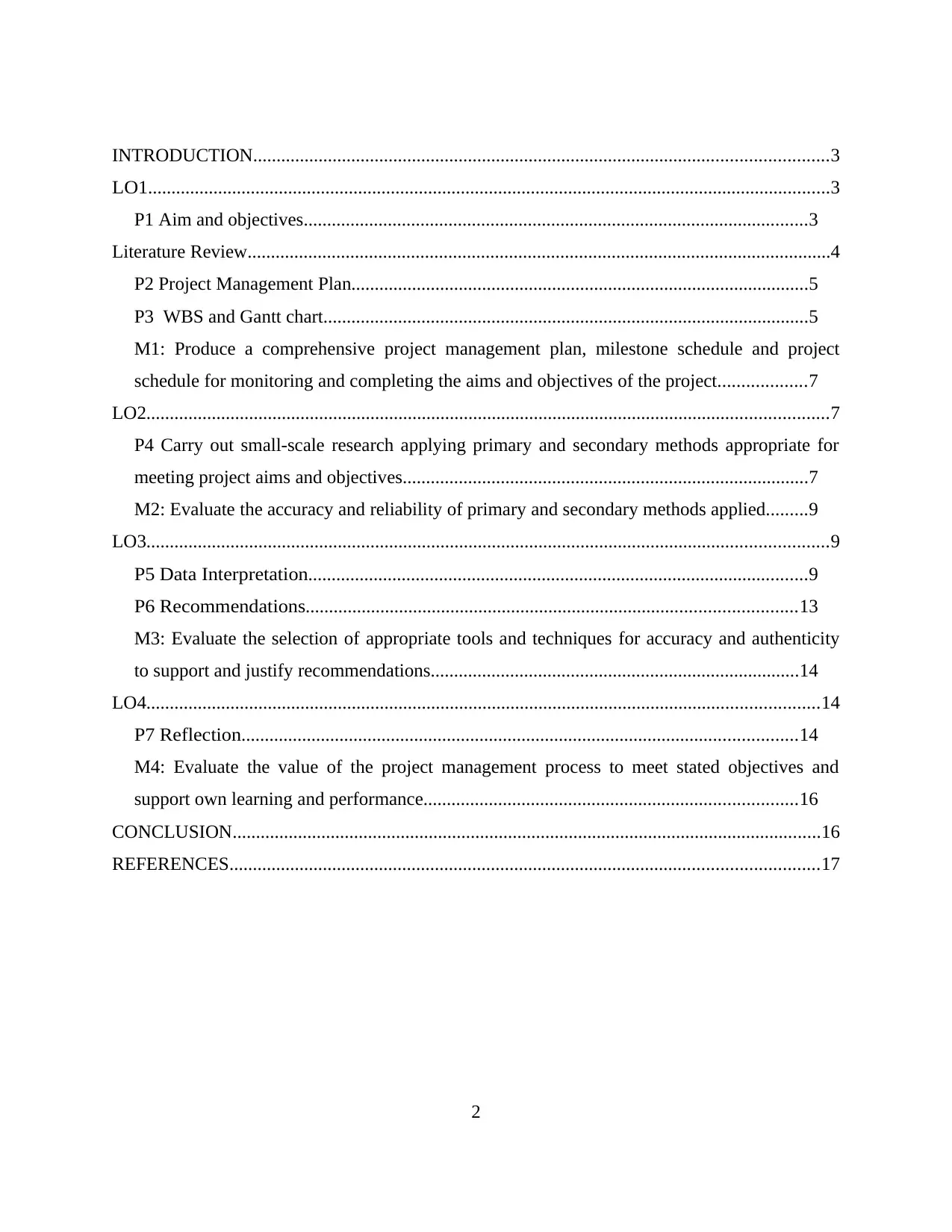
INTRODUCTION...........................................................................................................................3
LO1..................................................................................................................................................3
P1 Aim and objectives............................................................................................................3
Literature Review.............................................................................................................................4
P2 Project Management Plan..................................................................................................5
P3 WBS and Gantt chart........................................................................................................5
M1: Produce a comprehensive project management plan, milestone schedule and project
schedule for monitoring and completing the aims and objectives of the project...................7
LO2..................................................................................................................................................7
P4 Carry out small-scale research applying primary and secondary methods appropriate for
meeting project aims and objectives.......................................................................................7
M2: Evaluate the accuracy and reliability of primary and secondary methods applied.........9
LO3..................................................................................................................................................9
P5 Data Interpretation...........................................................................................................9
P6 Recommendations.........................................................................................................13
M3: Evaluate the selection of appropriate tools and techniques for accuracy and authenticity
to support and justify recommendations...............................................................................14
LO4................................................................................................................................................14
P7 Reflection.......................................................................................................................14
M4: Evaluate the value of the project management process to meet stated objectives and
support own learning and performance................................................................................16
CONCLUSION..............................................................................................................................16
REFERENCES..............................................................................................................................17
2
LO1..................................................................................................................................................3
P1 Aim and objectives............................................................................................................3
Literature Review.............................................................................................................................4
P2 Project Management Plan..................................................................................................5
P3 WBS and Gantt chart........................................................................................................5
M1: Produce a comprehensive project management plan, milestone schedule and project
schedule for monitoring and completing the aims and objectives of the project...................7
LO2..................................................................................................................................................7
P4 Carry out small-scale research applying primary and secondary methods appropriate for
meeting project aims and objectives.......................................................................................7
M2: Evaluate the accuracy and reliability of primary and secondary methods applied.........9
LO3..................................................................................................................................................9
P5 Data Interpretation...........................................................................................................9
P6 Recommendations.........................................................................................................13
M3: Evaluate the selection of appropriate tools and techniques for accuracy and authenticity
to support and justify recommendations...............................................................................14
LO4................................................................................................................................................14
P7 Reflection.......................................................................................................................14
M4: Evaluate the value of the project management process to meet stated objectives and
support own learning and performance................................................................................16
CONCLUSION..............................................................................................................................16
REFERENCES..............................................................................................................................17
2
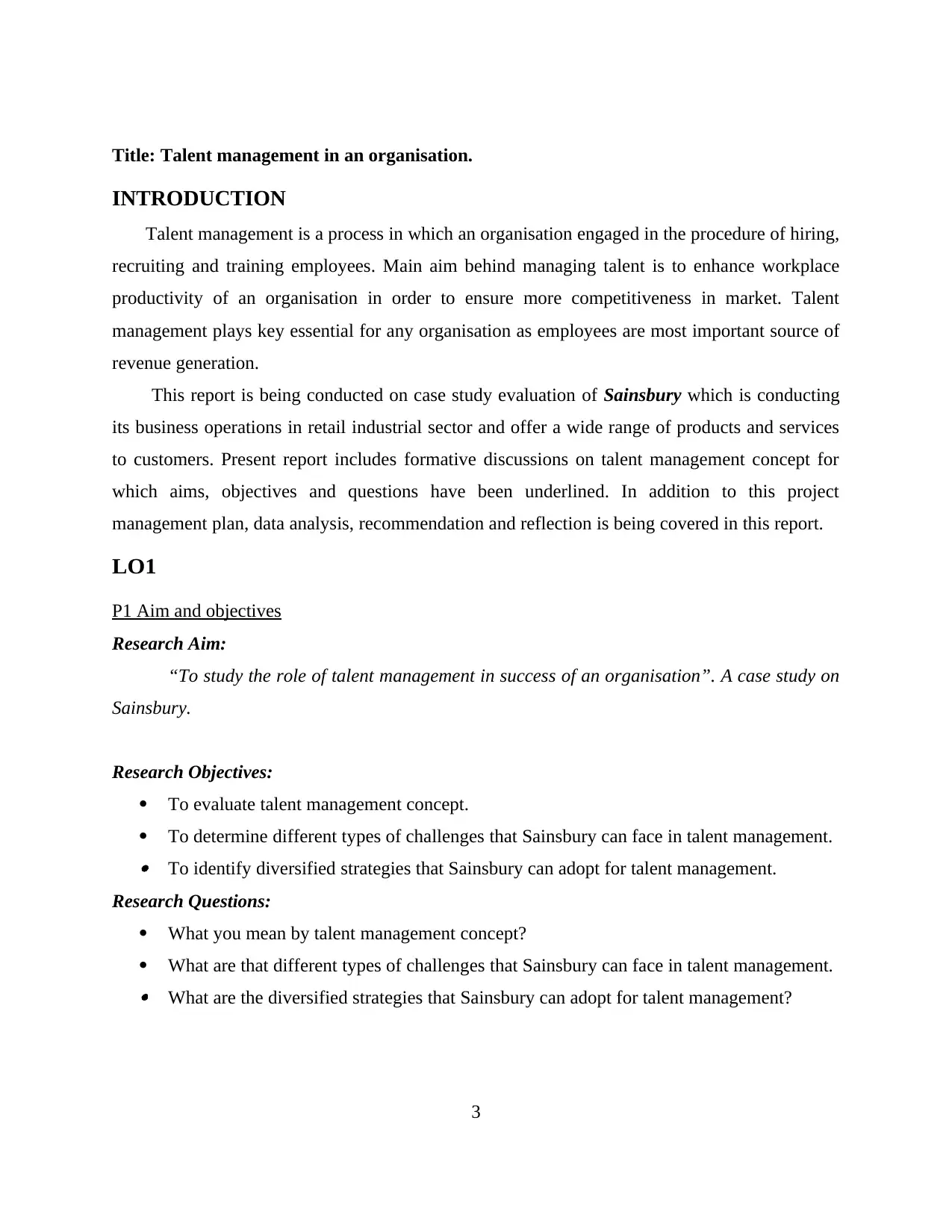
Title: Talent management in an organisation.
INTRODUCTION
Talent management is a process in which an organisation engaged in the procedure of hiring,
recruiting and training employees. Main aim behind managing talent is to enhance workplace
productivity of an organisation in order to ensure more competitiveness in market. Talent
management plays key essential for any organisation as employees are most important source of
revenue generation.
This report is being conducted on case study evaluation of Sainsbury which is conducting
its business operations in retail industrial sector and offer a wide range of products and services
to customers. Present report includes formative discussions on talent management concept for
which aims, objectives and questions have been underlined. In addition to this project
management plan, data analysis, recommendation and reflection is being covered in this report.
LO1
P1 Aim and objectives
Research Aim:
“To study the role of talent management in success of an organisation”. A case study on
Sainsbury.
Research Objectives:
To evaluate talent management concept.
To determine different types of challenges that Sainsbury can face in talent management. To identify diversified strategies that Sainsbury can adopt for talent management.
Research Questions:
What you mean by talent management concept?
What are that different types of challenges that Sainsbury can face in talent management. What are the diversified strategies that Sainsbury can adopt for talent management?
3
INTRODUCTION
Talent management is a process in which an organisation engaged in the procedure of hiring,
recruiting and training employees. Main aim behind managing talent is to enhance workplace
productivity of an organisation in order to ensure more competitiveness in market. Talent
management plays key essential for any organisation as employees are most important source of
revenue generation.
This report is being conducted on case study evaluation of Sainsbury which is conducting
its business operations in retail industrial sector and offer a wide range of products and services
to customers. Present report includes formative discussions on talent management concept for
which aims, objectives and questions have been underlined. In addition to this project
management plan, data analysis, recommendation and reflection is being covered in this report.
LO1
P1 Aim and objectives
Research Aim:
“To study the role of talent management in success of an organisation”. A case study on
Sainsbury.
Research Objectives:
To evaluate talent management concept.
To determine different types of challenges that Sainsbury can face in talent management. To identify diversified strategies that Sainsbury can adopt for talent management.
Research Questions:
What you mean by talent management concept?
What are that different types of challenges that Sainsbury can face in talent management. What are the diversified strategies that Sainsbury can adopt for talent management?
3
⊘ This is a preview!⊘
Do you want full access?
Subscribe today to unlock all pages.

Trusted by 1+ million students worldwide
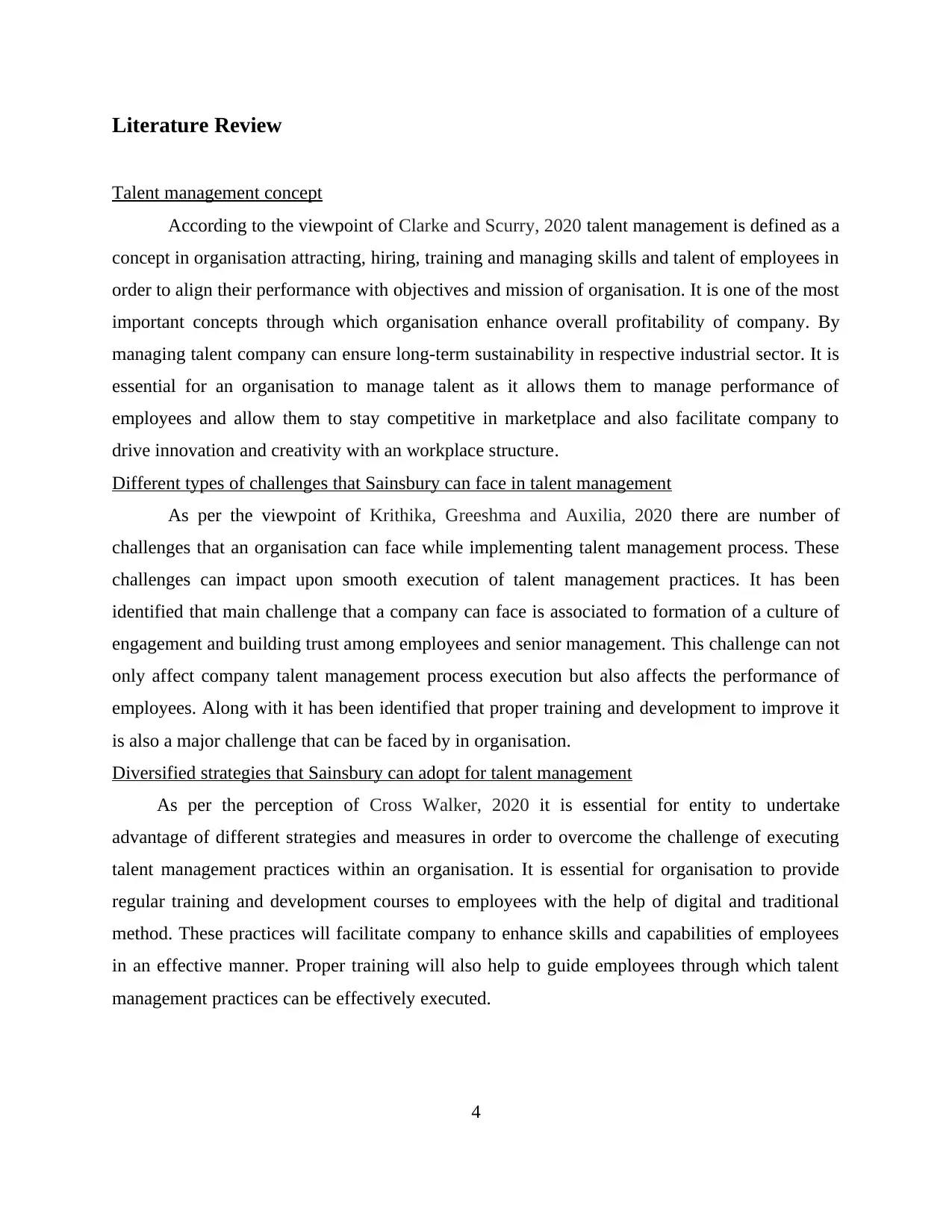
Literature Review
Talent management concept
According to the viewpoint of Clarke and Scurry, 2020 talent management is defined as a
concept in organisation attracting, hiring, training and managing skills and talent of employees in
order to align their performance with objectives and mission of organisation. It is one of the most
important concepts through which organisation enhance overall profitability of company. By
managing talent company can ensure long-term sustainability in respective industrial sector. It is
essential for an organisation to manage talent as it allows them to manage performance of
employees and allow them to stay competitive in marketplace and also facilitate company to
drive innovation and creativity with an workplace structure.
Different types of challenges that Sainsbury can face in talent management
As per the viewpoint of Krithika, Greeshma and Auxilia, 2020 there are number of
challenges that an organisation can face while implementing talent management process. These
challenges can impact upon smooth execution of talent management practices. It has been
identified that main challenge that a company can face is associated to formation of a culture of
engagement and building trust among employees and senior management. This challenge can not
only affect company talent management process execution but also affects the performance of
employees. Along with it has been identified that proper training and development to improve it
is also a major challenge that can be faced by in organisation.
Diversified strategies that Sainsbury can adopt for talent management
As per the perception of Cross Walker, 2020 it is essential for entity to undertake
advantage of different strategies and measures in order to overcome the challenge of executing
talent management practices within an organisation. It is essential for organisation to provide
regular training and development courses to employees with the help of digital and traditional
method. These practices will facilitate company to enhance skills and capabilities of employees
in an effective manner. Proper training will also help to guide employees through which talent
management practices can be effectively executed.
4
Talent management concept
According to the viewpoint of Clarke and Scurry, 2020 talent management is defined as a
concept in organisation attracting, hiring, training and managing skills and talent of employees in
order to align their performance with objectives and mission of organisation. It is one of the most
important concepts through which organisation enhance overall profitability of company. By
managing talent company can ensure long-term sustainability in respective industrial sector. It is
essential for an organisation to manage talent as it allows them to manage performance of
employees and allow them to stay competitive in marketplace and also facilitate company to
drive innovation and creativity with an workplace structure.
Different types of challenges that Sainsbury can face in talent management
As per the viewpoint of Krithika, Greeshma and Auxilia, 2020 there are number of
challenges that an organisation can face while implementing talent management process. These
challenges can impact upon smooth execution of talent management practices. It has been
identified that main challenge that a company can face is associated to formation of a culture of
engagement and building trust among employees and senior management. This challenge can not
only affect company talent management process execution but also affects the performance of
employees. Along with it has been identified that proper training and development to improve it
is also a major challenge that can be faced by in organisation.
Diversified strategies that Sainsbury can adopt for talent management
As per the perception of Cross Walker, 2020 it is essential for entity to undertake
advantage of different strategies and measures in order to overcome the challenge of executing
talent management practices within an organisation. It is essential for organisation to provide
regular training and development courses to employees with the help of digital and traditional
method. These practices will facilitate company to enhance skills and capabilities of employees
in an effective manner. Proper training will also help to guide employees through which talent
management practices can be effectively executed.
4
Paraphrase This Document
Need a fresh take? Get an instant paraphrase of this document with our AI Paraphraser
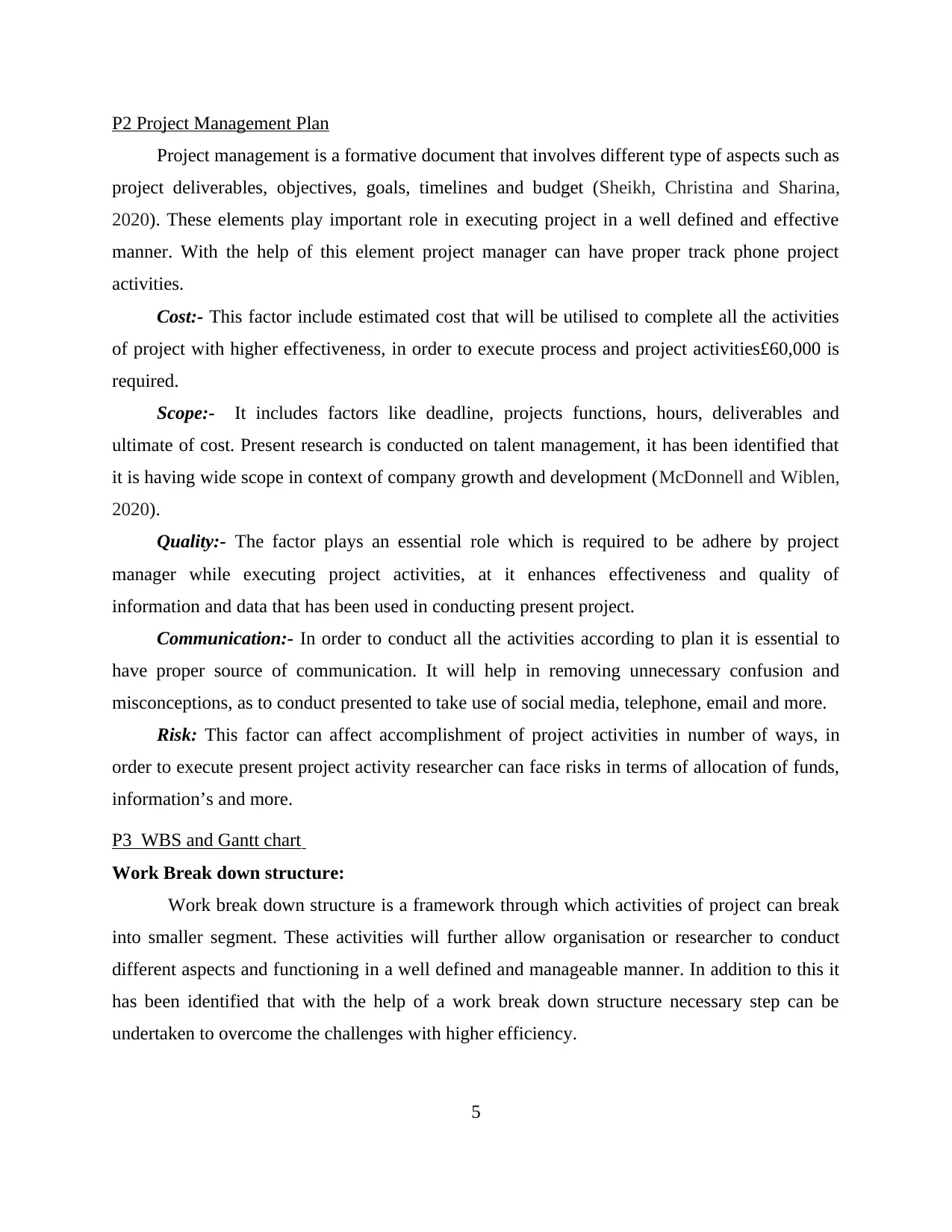
P2 Project Management Plan
Project management is a formative document that involves different type of aspects such as
project deliverables, objectives, goals, timelines and budget (Sheikh, Christina and Sharina,
2020). These elements play important role in executing project in a well defined and effective
manner. With the help of this element project manager can have proper track phone project
activities.
Cost:- This factor include estimated cost that will be utilised to complete all the activities
of project with higher effectiveness, in order to execute process and project activities£60,000 is
required.
Scope:- It includes factors like deadline, projects functions, hours, deliverables and
ultimate of cost. Present research is conducted on talent management, it has been identified that
it is having wide scope in context of company growth and development (McDonnell and Wiblen,
2020).
Quality:- The factor plays an essential role which is required to be adhere by project
manager while executing project activities, at it enhances effectiveness and quality of
information and data that has been used in conducting present project.
Communication:- In order to conduct all the activities according to plan it is essential to
have proper source of communication. It will help in removing unnecessary confusion and
misconceptions, as to conduct presented to take use of social media, telephone, email and more.
Risk: This factor can affect accomplishment of project activities in number of ways, in
order to execute present project activity researcher can face risks in terms of allocation of funds,
information’s and more.
P3 WBS and Gantt chart
Work Break down structure:
Work break down structure is a framework through which activities of project can break
into smaller segment. These activities will further allow organisation or researcher to conduct
different aspects and functioning in a well defined and manageable manner. In addition to this it
has been identified that with the help of a work break down structure necessary step can be
undertaken to overcome the challenges with higher efficiency.
5
Project management is a formative document that involves different type of aspects such as
project deliverables, objectives, goals, timelines and budget (Sheikh, Christina and Sharina,
2020). These elements play important role in executing project in a well defined and effective
manner. With the help of this element project manager can have proper track phone project
activities.
Cost:- This factor include estimated cost that will be utilised to complete all the activities
of project with higher effectiveness, in order to execute process and project activities£60,000 is
required.
Scope:- It includes factors like deadline, projects functions, hours, deliverables and
ultimate of cost. Present research is conducted on talent management, it has been identified that
it is having wide scope in context of company growth and development (McDonnell and Wiblen,
2020).
Quality:- The factor plays an essential role which is required to be adhere by project
manager while executing project activities, at it enhances effectiveness and quality of
information and data that has been used in conducting present project.
Communication:- In order to conduct all the activities according to plan it is essential to
have proper source of communication. It will help in removing unnecessary confusion and
misconceptions, as to conduct presented to take use of social media, telephone, email and more.
Risk: This factor can affect accomplishment of project activities in number of ways, in
order to execute present project activity researcher can face risks in terms of allocation of funds,
information’s and more.
P3 WBS and Gantt chart
Work Break down structure:
Work break down structure is a framework through which activities of project can break
into smaller segment. These activities will further allow organisation or researcher to conduct
different aspects and functioning in a well defined and manageable manner. In addition to this it
has been identified that with the help of a work break down structure necessary step can be
undertaken to overcome the challenges with higher efficiency.
5
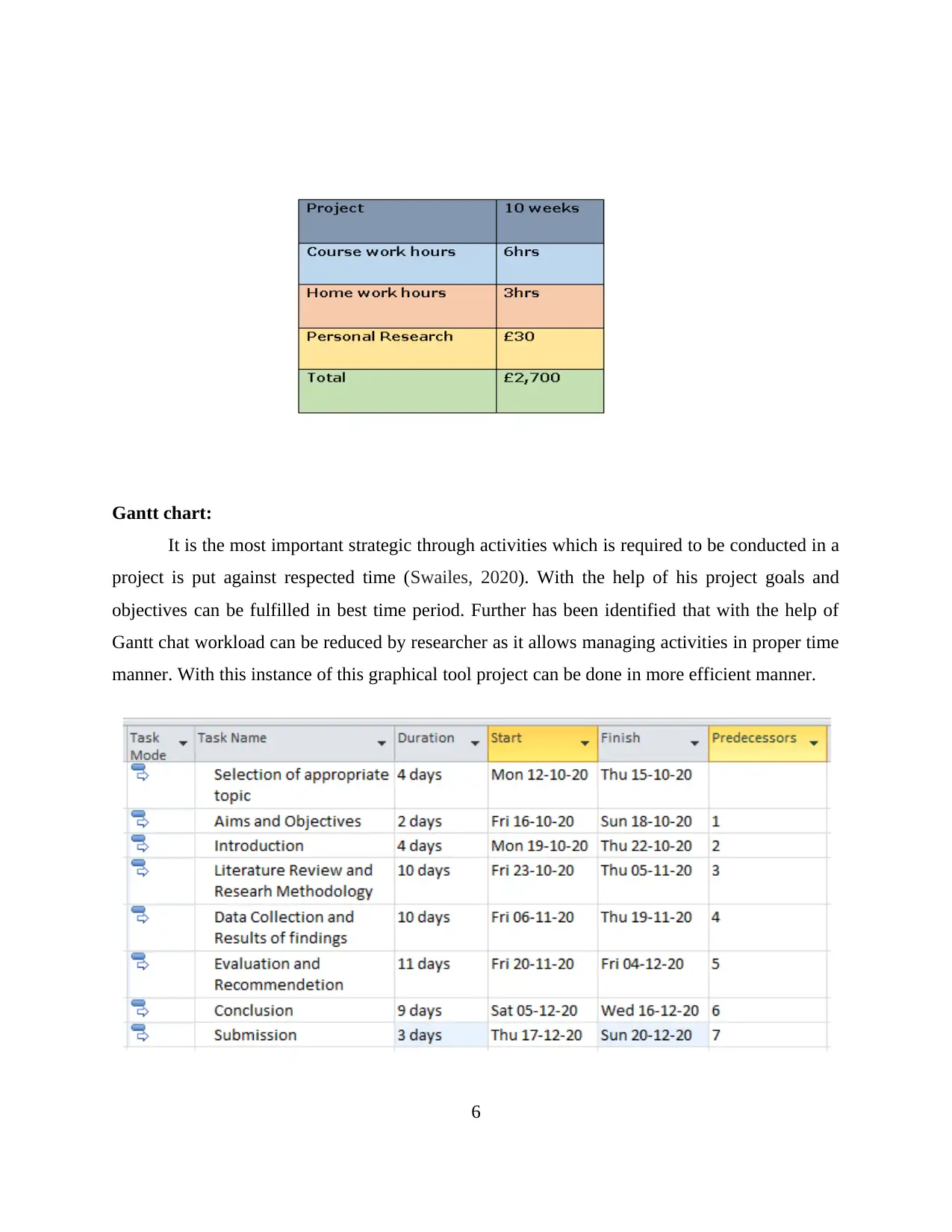
Gantt chart:
It is the most important strategic through activities which is required to be conducted in a
project is put against respected time (Swailes, 2020). With the help of his project goals and
objectives can be fulfilled in best time period. Further has been identified that with the help of
Gantt chat workload can be reduced by researcher as it allows managing activities in proper time
manner. With this instance of this graphical tool project can be done in more efficient manner.
6
It is the most important strategic through activities which is required to be conducted in a
project is put against respected time (Swailes, 2020). With the help of his project goals and
objectives can be fulfilled in best time period. Further has been identified that with the help of
Gantt chat workload can be reduced by researcher as it allows managing activities in proper time
manner. With this instance of this graphical tool project can be done in more efficient manner.
6
⊘ This is a preview!⊘
Do you want full access?
Subscribe today to unlock all pages.

Trusted by 1+ million students worldwide
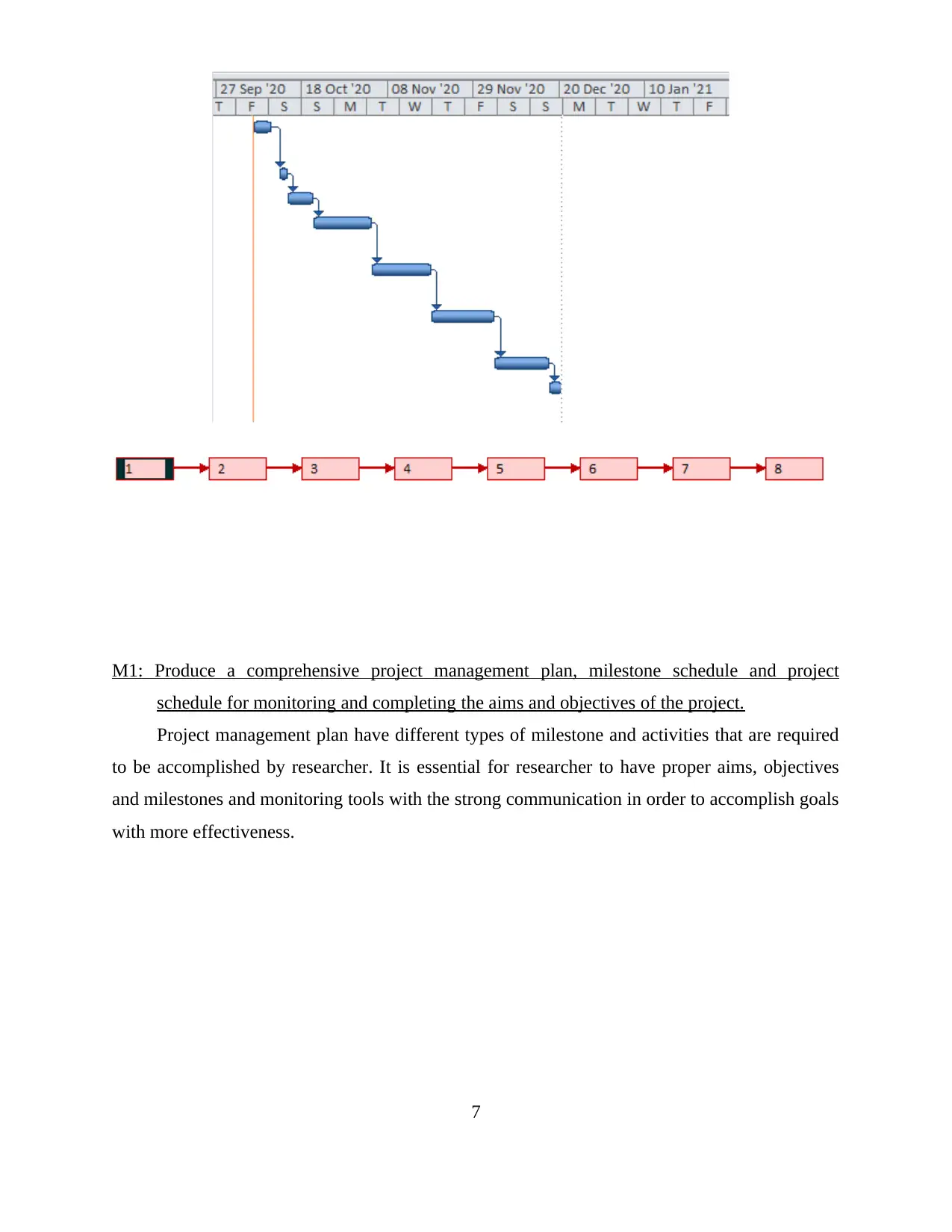
M1: Produce a comprehensive project management plan, milestone schedule and project
schedule for monitoring and completing the aims and objectives of the project.
Project management plan have different types of milestone and activities that are required
to be accomplished by researcher. It is essential for researcher to have proper aims, objectives
and milestones and monitoring tools with the strong communication in order to accomplish goals
with more effectiveness.
7
schedule for monitoring and completing the aims and objectives of the project.
Project management plan have different types of milestone and activities that are required
to be accomplished by researcher. It is essential for researcher to have proper aims, objectives
and milestones and monitoring tools with the strong communication in order to accomplish goals
with more effectiveness.
7
Paraphrase This Document
Need a fresh take? Get an instant paraphrase of this document with our AI Paraphraser
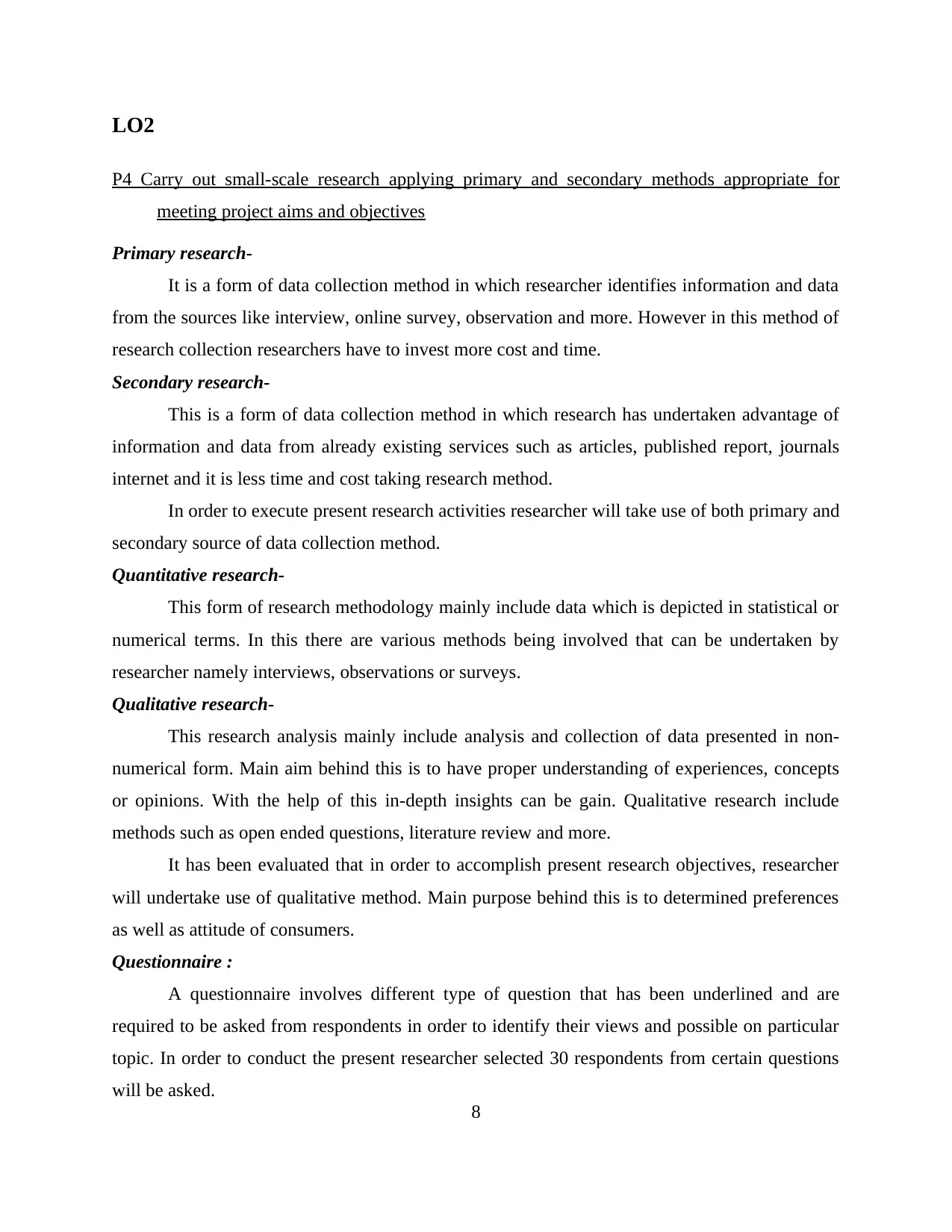
LO2
P4 Carry out small-scale research applying primary and secondary methods appropriate for
meeting project aims and objectives
Primary research-
It is a form of data collection method in which researcher identifies information and data
from the sources like interview, online survey, observation and more. However in this method of
research collection researchers have to invest more cost and time.
Secondary research-
This is a form of data collection method in which research has undertaken advantage of
information and data from already existing services such as articles, published report, journals
internet and it is less time and cost taking research method.
In order to execute present research activities researcher will take use of both primary and
secondary source of data collection method.
Quantitative research-
This form of research methodology mainly include data which is depicted in statistical or
numerical terms. In this there are various methods being involved that can be undertaken by
researcher namely interviews, observations or surveys.
Qualitative research-
This research analysis mainly include analysis and collection of data presented in non-
numerical form. Main aim behind this is to have proper understanding of experiences, concepts
or opinions. With the help of this in-depth insights can be gain. Qualitative research include
methods such as open ended questions, literature review and more.
It has been evaluated that in order to accomplish present research objectives, researcher
will undertake use of qualitative method. Main purpose behind this is to determined preferences
as well as attitude of consumers.
Questionnaire :
A questionnaire involves different type of question that has been underlined and are
required to be asked from respondents in order to identify their views and possible on particular
topic. In order to conduct the present researcher selected 30 respondents from certain questions
will be asked.
8
P4 Carry out small-scale research applying primary and secondary methods appropriate for
meeting project aims and objectives
Primary research-
It is a form of data collection method in which researcher identifies information and data
from the sources like interview, online survey, observation and more. However in this method of
research collection researchers have to invest more cost and time.
Secondary research-
This is a form of data collection method in which research has undertaken advantage of
information and data from already existing services such as articles, published report, journals
internet and it is less time and cost taking research method.
In order to execute present research activities researcher will take use of both primary and
secondary source of data collection method.
Quantitative research-
This form of research methodology mainly include data which is depicted in statistical or
numerical terms. In this there are various methods being involved that can be undertaken by
researcher namely interviews, observations or surveys.
Qualitative research-
This research analysis mainly include analysis and collection of data presented in non-
numerical form. Main aim behind this is to have proper understanding of experiences, concepts
or opinions. With the help of this in-depth insights can be gain. Qualitative research include
methods such as open ended questions, literature review and more.
It has been evaluated that in order to accomplish present research objectives, researcher
will undertake use of qualitative method. Main purpose behind this is to determined preferences
as well as attitude of consumers.
Questionnaire :
A questionnaire involves different type of question that has been underlined and are
required to be asked from respondents in order to identify their views and possible on particular
topic. In order to conduct the present researcher selected 30 respondents from certain questions
will be asked.
8
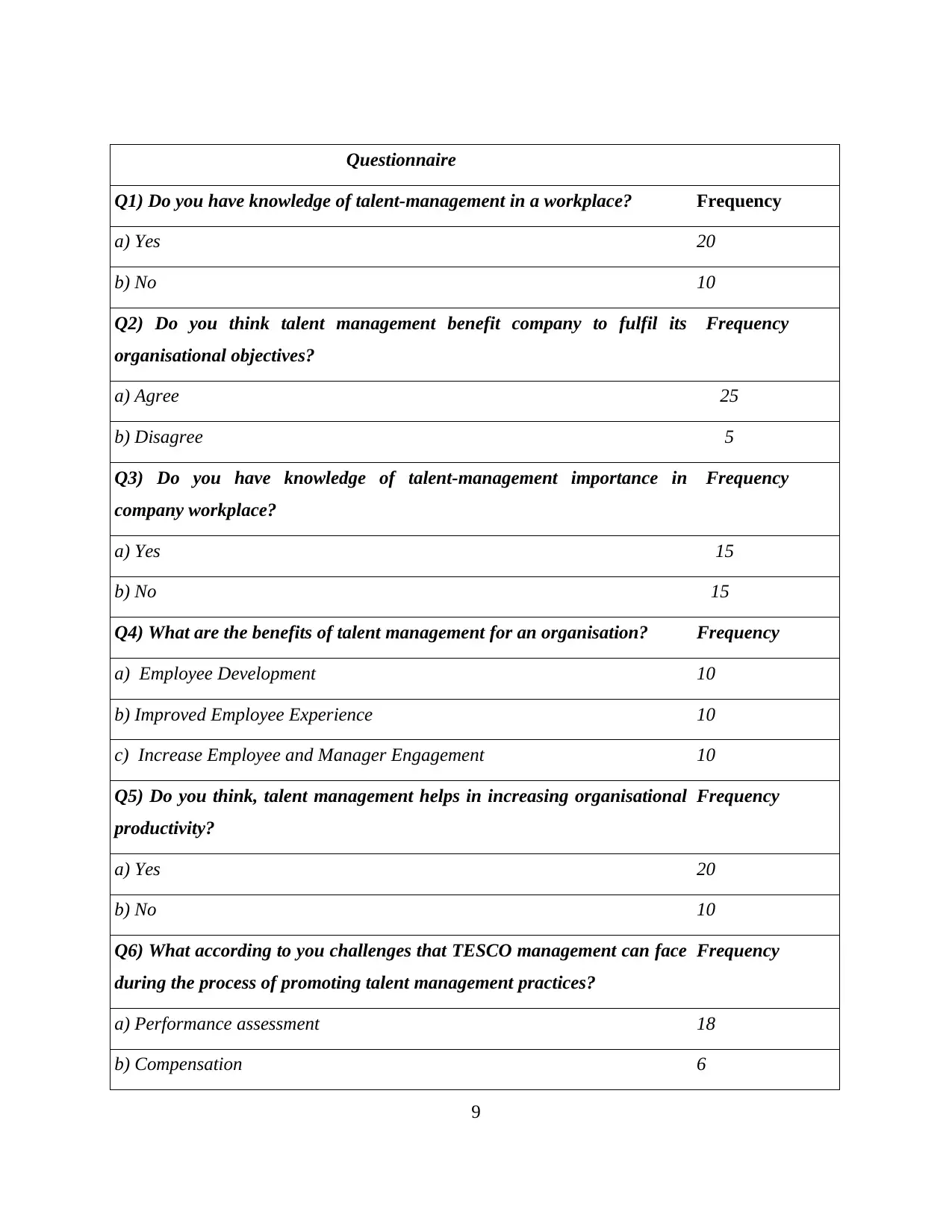
Questionnaire
Q1) Do you have knowledge of talent-management in a workplace? Frequency
a) Yes 20
b) No 10
Q2) Do you think talent management benefit company to fulfil its
organisational objectives?
Frequency
a) Agree 25
b) Disagree 5
Q3) Do you have knowledge of talent-management importance in
company workplace?
Frequency
a) Yes 15
b) No 15
Q4) What are the benefits of talent management for an organisation? Frequency
a) Employee Development 10
b) Improved Employee Experience 10
c) Increase Employee and Manager Engagement 10
Q5) Do you think, talent management helps in increasing organisational
productivity?
Frequency
a) Yes 20
b) No 10
Q6) What according to you challenges that TESCO management can face
during the process of promoting talent management practices?
Frequency
a) Performance assessment 18
b) Compensation 6
9
Q1) Do you have knowledge of talent-management in a workplace? Frequency
a) Yes 20
b) No 10
Q2) Do you think talent management benefit company to fulfil its
organisational objectives?
Frequency
a) Agree 25
b) Disagree 5
Q3) Do you have knowledge of talent-management importance in
company workplace?
Frequency
a) Yes 15
b) No 15
Q4) What are the benefits of talent management for an organisation? Frequency
a) Employee Development 10
b) Improved Employee Experience 10
c) Increase Employee and Manager Engagement 10
Q5) Do you think, talent management helps in increasing organisational
productivity?
Frequency
a) Yes 20
b) No 10
Q6) What according to you challenges that TESCO management can face
during the process of promoting talent management practices?
Frequency
a) Performance assessment 18
b) Compensation 6
9
⊘ This is a preview!⊘
Do you want full access?
Subscribe today to unlock all pages.

Trusted by 1+ million students worldwide
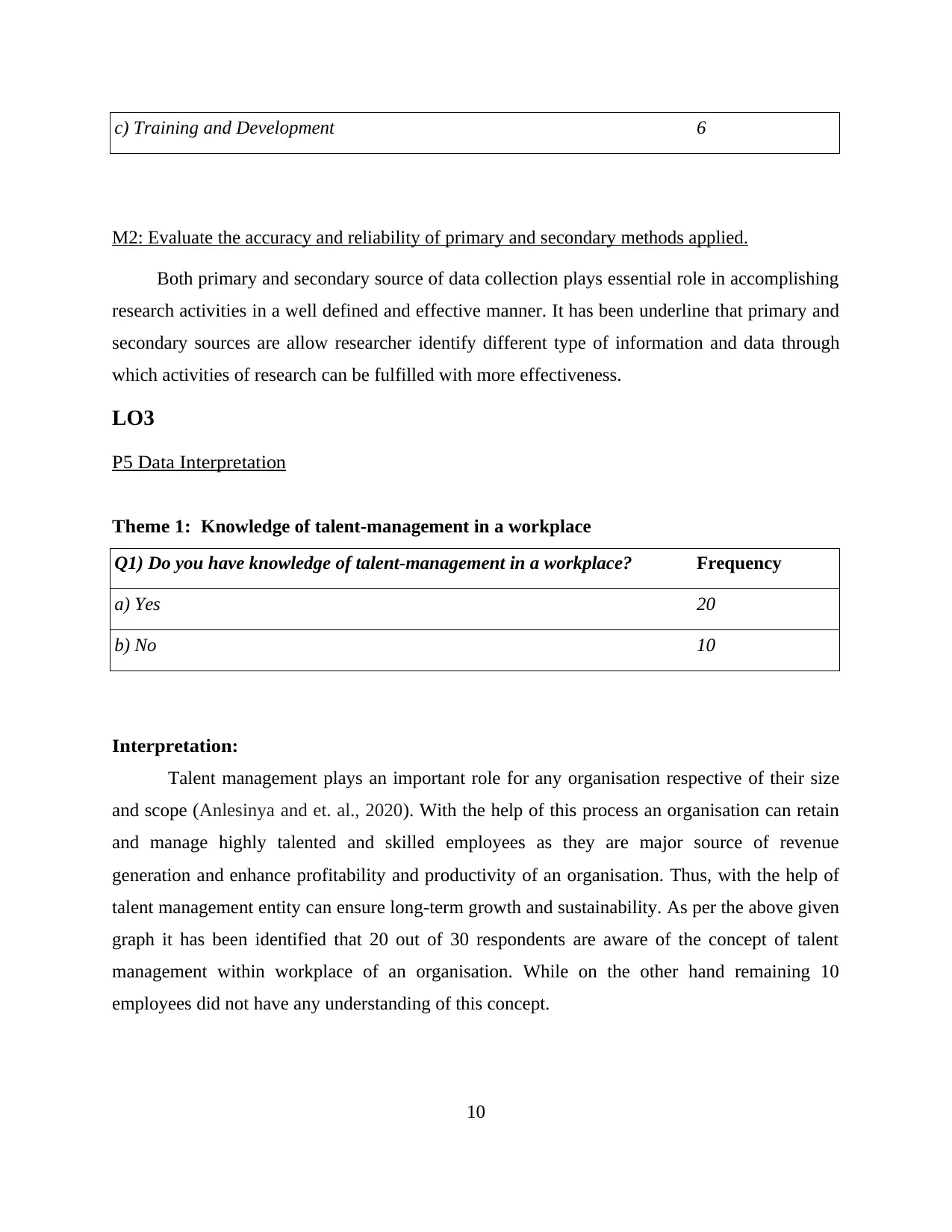
c) Training and Development 6
M2: Evaluate the accuracy and reliability of primary and secondary methods applied.
Both primary and secondary source of data collection plays essential role in accomplishing
research activities in a well defined and effective manner. It has been underline that primary and
secondary sources are allow researcher identify different type of information and data through
which activities of research can be fulfilled with more effectiveness.
LO3
P5 Data Interpretation
Theme 1: Knowledge of talent-management in a workplace
Q1) Do you have knowledge of talent-management in a workplace? Frequency
a) Yes 20
b) No 10
Interpretation:
Talent management plays an important role for any organisation respective of their size
and scope (Anlesinya and et. al., 2020). With the help of this process an organisation can retain
and manage highly talented and skilled employees as they are major source of revenue
generation and enhance profitability and productivity of an organisation. Thus, with the help of
talent management entity can ensure long-term growth and sustainability. As per the above given
graph it has been identified that 20 out of 30 respondents are aware of the concept of talent
management within workplace of an organisation. While on the other hand remaining 10
employees did not have any understanding of this concept.
10
M2: Evaluate the accuracy and reliability of primary and secondary methods applied.
Both primary and secondary source of data collection plays essential role in accomplishing
research activities in a well defined and effective manner. It has been underline that primary and
secondary sources are allow researcher identify different type of information and data through
which activities of research can be fulfilled with more effectiveness.
LO3
P5 Data Interpretation
Theme 1: Knowledge of talent-management in a workplace
Q1) Do you have knowledge of talent-management in a workplace? Frequency
a) Yes 20
b) No 10
Interpretation:
Talent management plays an important role for any organisation respective of their size
and scope (Anlesinya and et. al., 2020). With the help of this process an organisation can retain
and manage highly talented and skilled employees as they are major source of revenue
generation and enhance profitability and productivity of an organisation. Thus, with the help of
talent management entity can ensure long-term growth and sustainability. As per the above given
graph it has been identified that 20 out of 30 respondents are aware of the concept of talent
management within workplace of an organisation. While on the other hand remaining 10
employees did not have any understanding of this concept.
10
Paraphrase This Document
Need a fresh take? Get an instant paraphrase of this document with our AI Paraphraser
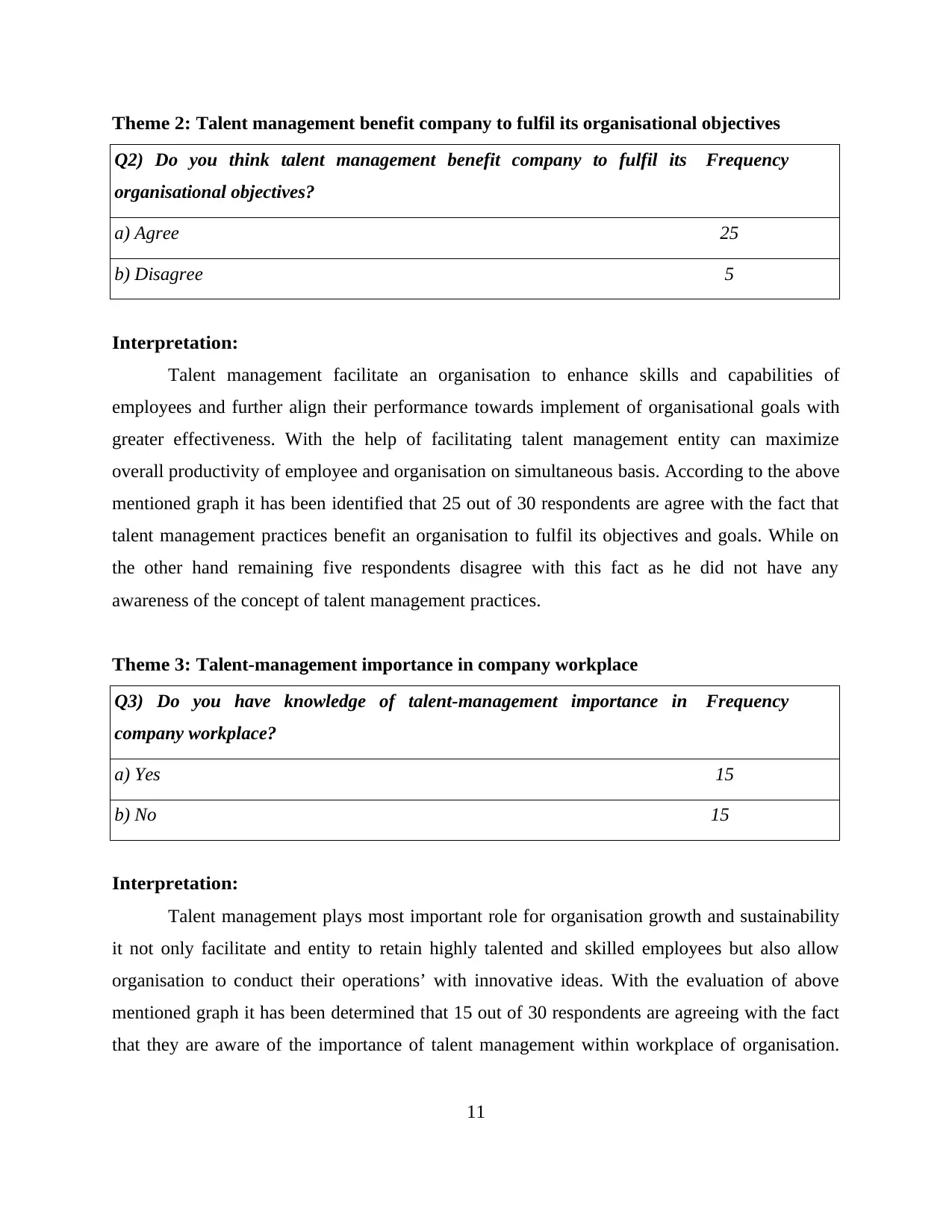
Theme 2: Talent management benefit company to fulfil its organisational objectives
Q2) Do you think talent management benefit company to fulfil its
organisational objectives?
Frequency
a) Agree 25
b) Disagree 5
Interpretation:
Talent management facilitate an organisation to enhance skills and capabilities of
employees and further align their performance towards implement of organisational goals with
greater effectiveness. With the help of facilitating talent management entity can maximize
overall productivity of employee and organisation on simultaneous basis. According to the above
mentioned graph it has been identified that 25 out of 30 respondents are agree with the fact that
talent management practices benefit an organisation to fulfil its objectives and goals. While on
the other hand remaining five respondents disagree with this fact as he did not have any
awareness of the concept of talent management practices.
Theme 3: Talent-management importance in company workplace
Q3) Do you have knowledge of talent-management importance in
company workplace?
Frequency
a) Yes 15
b) No 15
Interpretation:
Talent management plays most important role for organisation growth and sustainability
it not only facilitate and entity to retain highly talented and skilled employees but also allow
organisation to conduct their operations’ with innovative ideas. With the evaluation of above
mentioned graph it has been determined that 15 out of 30 respondents are agreeing with the fact
that they are aware of the importance of talent management within workplace of organisation.
11
Q2) Do you think talent management benefit company to fulfil its
organisational objectives?
Frequency
a) Agree 25
b) Disagree 5
Interpretation:
Talent management facilitate an organisation to enhance skills and capabilities of
employees and further align their performance towards implement of organisational goals with
greater effectiveness. With the help of facilitating talent management entity can maximize
overall productivity of employee and organisation on simultaneous basis. According to the above
mentioned graph it has been identified that 25 out of 30 respondents are agree with the fact that
talent management practices benefit an organisation to fulfil its objectives and goals. While on
the other hand remaining five respondents disagree with this fact as he did not have any
awareness of the concept of talent management practices.
Theme 3: Talent-management importance in company workplace
Q3) Do you have knowledge of talent-management importance in
company workplace?
Frequency
a) Yes 15
b) No 15
Interpretation:
Talent management plays most important role for organisation growth and sustainability
it not only facilitate and entity to retain highly talented and skilled employees but also allow
organisation to conduct their operations’ with innovative ideas. With the evaluation of above
mentioned graph it has been determined that 15 out of 30 respondents are agreeing with the fact
that they are aware of the importance of talent management within workplace of organisation.
11
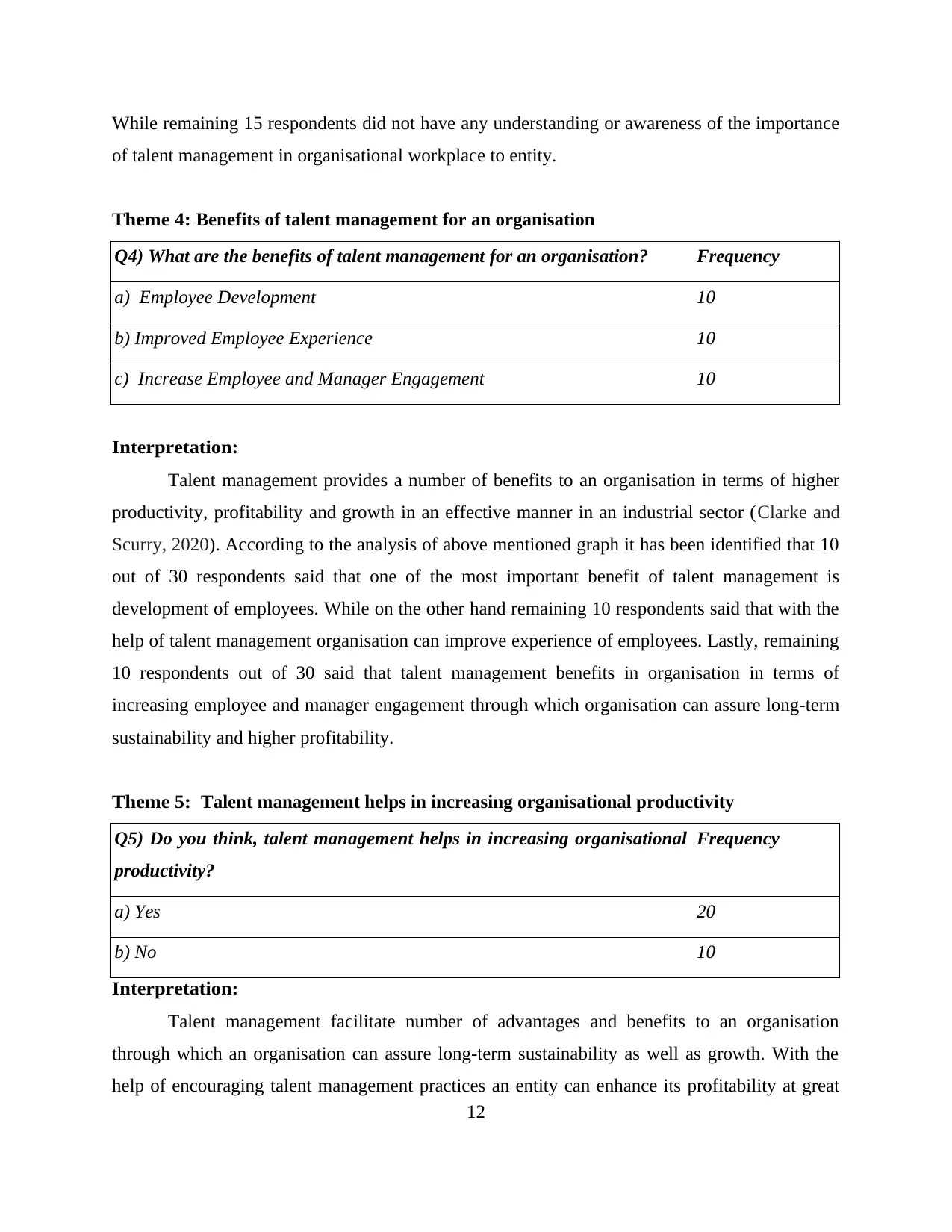
While remaining 15 respondents did not have any understanding or awareness of the importance
of talent management in organisational workplace to entity.
Theme 4: Benefits of talent management for an organisation
Q4) What are the benefits of talent management for an organisation? Frequency
a) Employee Development 10
b) Improved Employee Experience 10
c) Increase Employee and Manager Engagement 10
Interpretation:
Talent management provides a number of benefits to an organisation in terms of higher
productivity, profitability and growth in an effective manner in an industrial sector (Clarke and
Scurry, 2020). According to the analysis of above mentioned graph it has been identified that 10
out of 30 respondents said that one of the most important benefit of talent management is
development of employees. While on the other hand remaining 10 respondents said that with the
help of talent management organisation can improve experience of employees. Lastly, remaining
10 respondents out of 30 said that talent management benefits in organisation in terms of
increasing employee and manager engagement through which organisation can assure long-term
sustainability and higher profitability.
Theme 5: Talent management helps in increasing organisational productivity
Q5) Do you think, talent management helps in increasing organisational
productivity?
Frequency
a) Yes 20
b) No 10
Interpretation:
Talent management facilitate number of advantages and benefits to an organisation
through which an organisation can assure long-term sustainability as well as growth. With the
help of encouraging talent management practices an entity can enhance its profitability at great
12
of talent management in organisational workplace to entity.
Theme 4: Benefits of talent management for an organisation
Q4) What are the benefits of talent management for an organisation? Frequency
a) Employee Development 10
b) Improved Employee Experience 10
c) Increase Employee and Manager Engagement 10
Interpretation:
Talent management provides a number of benefits to an organisation in terms of higher
productivity, profitability and growth in an effective manner in an industrial sector (Clarke and
Scurry, 2020). According to the analysis of above mentioned graph it has been identified that 10
out of 30 respondents said that one of the most important benefit of talent management is
development of employees. While on the other hand remaining 10 respondents said that with the
help of talent management organisation can improve experience of employees. Lastly, remaining
10 respondents out of 30 said that talent management benefits in organisation in terms of
increasing employee and manager engagement through which organisation can assure long-term
sustainability and higher profitability.
Theme 5: Talent management helps in increasing organisational productivity
Q5) Do you think, talent management helps in increasing organisational
productivity?
Frequency
a) Yes 20
b) No 10
Interpretation:
Talent management facilitate number of advantages and benefits to an organisation
through which an organisation can assure long-term sustainability as well as growth. With the
help of encouraging talent management practices an entity can enhance its profitability at great
12
⊘ This is a preview!⊘
Do you want full access?
Subscribe today to unlock all pages.

Trusted by 1+ million students worldwide
1 out of 21
Related Documents
Your All-in-One AI-Powered Toolkit for Academic Success.
+13062052269
info@desklib.com
Available 24*7 on WhatsApp / Email
![[object Object]](/_next/static/media/star-bottom.7253800d.svg)
Unlock your academic potential
Copyright © 2020–2025 A2Z Services. All Rights Reserved. Developed and managed by ZUCOL.




